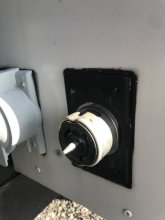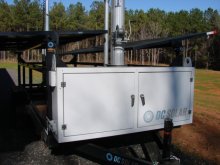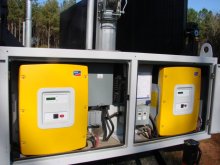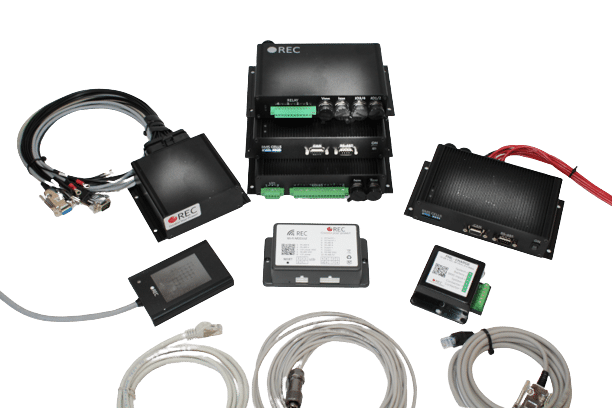Hedges
I See Electromagnetic Fields!
- Joined
- Mar 28, 2020
- Messages
- 20,682
They look like a great bundle.
Some have fresh forklift batteries, some old. I think retail was $5000 each, so it you get good ones you come out further ahead.
Some have a diesel generator. Ideal, since initially you'll just have the amount of PV that comes with the trailer.
Two SI6048 gives you 11.5 kW continuous at 25 degrees C.
If you buy two trailers, you can add one more RJ45 cable and daisy-chain all four SI6048 together.
Right now one is master, one is slave #1, and the AC is wired for 120/240V.
Reprogram the second trailer as slave #2 and slave #3 (simple pushbutton and menu on Sunny Island)
Wire the batteries in parallel.
Connect neutral AC wire together. Connect ground together.
(I would just run a 6 awg cable from each trailer to a 200A panel in the shop, join the two cables either on two 70A breakers or at the main lugs.)
Use a volt meter to see which AC L1/L2 on the two trailers belong on the same 120V leg, then wire those two pairs of hots together.
(Breaker off, measure voltages between inputs of the two 70A breakers. If zero volts between the two poles on same leg, it is correct, close breaker. If 240V, it's backwards. Shut off at trailer. Swap wires. Turn on at trailer, check that you now have zero volts between the breakers but 120V from breaker to neutral.)
You now have four SI6048 wired 2s2p for 23kW continuous, 28kW for 30 minutes, 44kW surge. Same as I have.
The trailers have a relatively small amount of PV, DC coupled with Midnight charge controller.
I think it is 2400W of PV (12 kWh/day) and 48 kWh of battery (two, 500 Ah 48V batteries).
You can use the shop for 1 day, consuming 35 kWh, then leave for 3 days and it will recharge (1 trailer).
With 2 trailers, you can use the shop all weekend, and return the next weekend.
That charge rate is probably less than ideal. The battery wants to be charged at 0.1C or 0.2C (check documentation). So better to have 5kW or 10kW of PV per trailer for best battery life. Or, run the generator (only one generator, no way to synchronize two)
When you want to add more, buy Sunny Boy and add that (AC coupled PV). They can go anywhere on your property the AC wiring reaches, like the roof of your workshop.
Even if battery wants 5 kW per trailer for 0.1C charging, you can put in 10 kW of PV/Sunny Boy. You just program a parameter in Sunny Island for battery charge current. The battery can get a regulated 5 kW (100A at 48V) while your shop tools get 5kW direct from PV.
Some have fresh forklift batteries, some old. I think retail was $5000 each, so it you get good ones you come out further ahead.
Some have a diesel generator. Ideal, since initially you'll just have the amount of PV that comes with the trailer.
Two SI6048 gives you 11.5 kW continuous at 25 degrees C.
If you buy two trailers, you can add one more RJ45 cable and daisy-chain all four SI6048 together.
Right now one is master, one is slave #1, and the AC is wired for 120/240V.
Reprogram the second trailer as slave #2 and slave #3 (simple pushbutton and menu on Sunny Island)
Wire the batteries in parallel.
Connect neutral AC wire together. Connect ground together.
(I would just run a 6 awg cable from each trailer to a 200A panel in the shop, join the two cables either on two 70A breakers or at the main lugs.)
Use a volt meter to see which AC L1/L2 on the two trailers belong on the same 120V leg, then wire those two pairs of hots together.
(Breaker off, measure voltages between inputs of the two 70A breakers. If zero volts between the two poles on same leg, it is correct, close breaker. If 240V, it's backwards. Shut off at trailer. Swap wires. Turn on at trailer, check that you now have zero volts between the breakers but 120V from breaker to neutral.)
You now have four SI6048 wired 2s2p for 23kW continuous, 28kW for 30 minutes, 44kW surge. Same as I have.
The trailers have a relatively small amount of PV, DC coupled with Midnight charge controller.
I think it is 2400W of PV (12 kWh/day) and 48 kWh of battery (two, 500 Ah 48V batteries).
You can use the shop for 1 day, consuming 35 kWh, then leave for 3 days and it will recharge (1 trailer).
With 2 trailers, you can use the shop all weekend, and return the next weekend.
That charge rate is probably less than ideal. The battery wants to be charged at 0.1C or 0.2C (check documentation). So better to have 5kW or 10kW of PV per trailer for best battery life. Or, run the generator (only one generator, no way to synchronize two)
When you want to add more, buy Sunny Boy and add that (AC coupled PV). They can go anywhere on your property the AC wiring reaches, like the roof of your workshop.
Even if battery wants 5 kW per trailer for 0.1C charging, you can put in 10 kW of PV/Sunny Boy. You just program a parameter in Sunny Island for battery charge current. The battery can get a regulated 5 kW (100A at 48V) while your shop tools get 5kW direct from PV.
Last edited:







